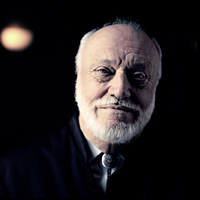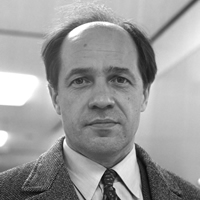Allegro
Reminiscences
Kurt Masur and Pierre Boulez
Volume 116, No. 3March, 2016
We recently lost two greats: Kurt Masur and Pierre Boulez. Both had served as music directors of the New York Philharmonic. We asked Local 802 musicians for their favorite memories. Here’s what they told us…

Kurt Masur (1927-2015). Photo: Frans Jansen
Kurt Masur was a larger-than-life musical presence on the concert stage. His interpretations of the great works of Schumann, Mendelssohn, Grieg and Beethoven were particularly profound. I often find myself quoting things he said to us about musical phrasing to my students. He shall definitely not be forgotten as his spirit will live on in all of us who were inspired by him.
Pierre Boulez was a Renaissance man: an amazing conductor as well as a groundbreaking composer. His music making was always intelligent, detailed and colorful. He was one of the great masters of French music and the possessor of the keenest ear of any conductor I ever knew.
– Glenn Dicterow
My favorite memories of Kurt Masur are with Beethoven, Mendelssohn, Brahms and Bruckner, and particularly works that include the chorus such as the Brahms Requiem. His passion and interpretive depth for this music really shaped us as an ensemble, and left a lasting impression on our approach. I will never again play a Bruckner symphony without thinking of him and the sound he inspired from the orchestra.
– Sheryl Staples
Kurt Masur was rooted in the classics and Pierre Boulez was an innovator and explorer of the contemporary. Both musicians possessed the finest ideals of their art.
– Stanley Drucker
I first met Kurt Masur in 1984 when I was a 19-year-old viola student at Tanglewood. I was principal when he conducted “Til Eulenspiegel” and Mahler 1. He was quite demanding, always respectful and completely inspiring. A little over a year later, I was the newest and youngest member of the New York Philharmonic and he was conducting the orchestra for what I believe might have been the first time. The rehearsal had started and was progressing well when, all of a sudden, he looked at me and stopped conducting. “Rebecca! Nice to see you!” Well, the only person more flabbergasted than my colleagues that he knew my name was me!
Once we were on tour somewhere, standing in a long customs line at the airport. I looked at the next line and saw Maestro Masur gently blowing on the back of the neck of his beloved wife Tomoko to get her attention or maybe simply to let her know he was there. To witness that small, loving gesture was so moving, so beautiful. There was this powerful, intimidating man, showing such unexpected tenderness. The moment has stuck with me. It was a glimpse of a side of him most of the world could never imagine.
One of the most important things I learned from Maestro Masur was that music is poetry. There should be meaning in every phrase, in every note. Yes, he was considered by many to be a tyrant on the podium. But the compassionate side I experienced when he called me at home when my mother died, the way he connected with an audience when he spoke (even with his less-than-perfect English) and the depth of meaning in all of his performances are just a few of the memories I will cherish for the rest of my life.
– Rebecca Young

Pierre Boulez (1925-2016). Photo: Joost Evers / Anefo
I liked Pierre Boulez and found him very easy to work with. If you were serious, paid careful attention to the ensemble, and played your part in tune and in correct rhythm, he was satisfied. He never indulged in personal tantrums or tirades. There were a couple of nicknames that some of our witty orchestra members came up with, because of all the contemporary and Second Viennese School music that he liked to program. One was “The 20th Century Limited,” which was a pun on the famous train from Chicago to New York. Another was “The French Correction,” which was a pun on the title of a current movie of that time, “The French Connection.” (This was because Maestro Boulez had the habit of correcting the various pitches of instruments during rehearsals.)
Boulez had some great ideas for programming. His first seasons featured two widely contrasting composers, Franz Liszt and Alban Berg. We played several works of each that many of us had never played before, such as Liszt’s “From the Cradle to the Grave” (which seemed almost serial in its loss of tonal center towards the end) and Berg’s “Der Wein” for mezzo-soprano and orchestra.
His second season contrasted Haydn and Stravinsky, a logical pair considering Stravinsky’s neoclassical leanings in one aspect of his changing style. We played some lesser known Haydn symphonies and Stravinsky works like the “Symphony for Psalms” and “Ragtime,” which were not as often performed as “Firebird” and “Rite of Spring.” Perhaps Boulez’s two greatest successes (and I think what he enjoyed the most) were the Prospective Encounters series and also the Rug Concerts.
In the first instance, he selected a small group of musicians from the New York Philharmonic, exempting them from the eight or more rehearsals and concerts uptown, and took us to play downtown at NYU (in the Eisner and Lubin auditoriums, seating about 400). Programs were for a chamber orchestra or even smaller group. We would play pieces like Stefan Wolpe’s “Concerto for Trumpet and 7 Instruments,” “Octandre” by Varese, or Ligeti’s “Chamber Concerto for 13 Instruments.” Boulez would answer questions from the audience after performing a work, then we would play the work again (resulting in greater understanding from the audience).
The Rug Concerts were very popular: all seats were $3 and the ground floor of our hall had all seats removed and replaced with foam rubber cushions. There were more cushions for seating on stage, and the orchestra played in the space just below the stage, so the audience was seated on the floor right next to us. Students loved to sit as close to their instrument group as possible. Boulez seemed exhilarated by the response of the predominately college-age audience. Needless to say, it was sold-out at every performance.
I would like to put in a word here for all orchestral musicians everywhere: it has been fashionable for music critics to write that “such-and-such an orchestra either likes or dislikes a conductor.” No attitude could be more wrongly portrayed. Every professional musician I have ever known has wished to collaborate with the kind of conductor exemplified by a Kleiber or a Bernstein, who allowed an orchestra to play its best. This means that each player, giving all that is possible to be his or her absolute best in every minute of a rehearsal or concert, is playing for the music, for the audience and for the conductor. I have never known any musician to want anything but to play beautifully, to serve the composer most of all. The miracle (which sometimes occurs at a rehearsal, not only at a concert) of a memorable flute, oboe, clarinet, bassoon or horn solo, the delicate shimmer of a pianissimo cymbal, or a concertmaster’s tender arpeggio – those are precious, shared, ideal moments that form the character of an orchestra.
– Orin O’Brien
In my first years with the New York Philharmonic (I started in April 1972) I was totally green and learning like a sponge. The level of music making and sharing the stage with so many top artists was a priceless experience.
My very first concert under the baton of Pierre Boulez was in Central Park in July 1972 – I remember sweating and “swimming” in Ravel’s “Daphnis and Chloe.” Most likely we played with very little rehearsal time and that was not a piece to sight read, especially when every one else knew it. (Those days, nobody – except maybe the principal players – took music home to learn. That was done during the rehearsals!)
My musical memory that stands out was a concert in 1975 at the Chartres Cathedral in France. Maybe the setting and acoustics inspired that performance of an unforgettable Mahler’s Ninth with its last movement so achingly moving and beautiful.
The tour in 1974 to New Zealand, Australia and Japan was shared by Bernstein and Boulez. Every concert ended with huge numbers of flowers brought to the stage. Lenny would throw the bouquets across the stage to mostly principal players. Pierre would gallantly walk to the ladies in order of their seniority in the ranks. So the first was Orin O’Brien, followed by Toby Sachs, Evangeline Benedetti, Shelly Saxon, Marilyn Dubow and finally me!
Once, during an evening concert, I suddenly realized I forgot to turn off my stove at home! I somehow conveyed this to Boulez and he smiled and sent me home immediately. I lived two blocks from Philhamonic Hall. My borsch had boiled away and the pot was ruined, but I was in time! To thank him, I invited him for dinner and he accepted. On the menu was another Polish soup – the “white borsch” made from sorrel. Apparently he knew and loved it from his mother’s kitchen.
When Maestro Boulez left the New York Philharmonic, a small group of us took him out. And so started a tradition of several dinners together in the next 30 years, in New York City, Paris and Lucerne.
I shared with both Mazur and Boulez a European heritage. We all had to understand, learn and adapt to American ways. There were some collisions along the way but ultimately music making of the highest order and genuine affection prevailed.
– Hanna Lachert
To contribute your favorite memories of Kurt Masur or Pierre Boulez, e-mail allegro@local802afm.org.
